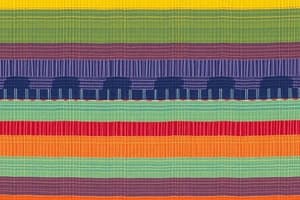Podcast
Questions and Answers
What is the primary reason for the crackling sound when removing a sweater?
What is the primary reason for the crackling sound when removing a sweater?
- Absorption of moisture by fibers (correct)
- Interweaving of fibers
- Presence of static electricity
- The type of fabric used
Which factor contributes to the loudness of the crackling sound when taking off a sweater?
Which factor contributes to the loudness of the crackling sound when taking off a sweater?
- Synthetic fibers like nylon or polyester
- Slow evaporation of moisture (correct)
- Presence of cotton fibers
- Natural fibers like wool or flax
What happens to the fibers' electric charge when a sweater is removed?
What happens to the fibers' electric charge when a sweater is removed?
- It remains constant
- It is completely discharged (correct)
- It increases rapidly
- It decreases gradually
How are sweaters typically constructed from fibers?
How are sweaters typically constructed from fibers?
Which type of fiber would be less likely to produce a loud crackling sound when removing a sweater?
Which type of fiber would be less likely to produce a loud crackling sound when removing a sweater?
What physical effect occurs in the fibers when moisture evaporates while removing a sweater?
What physical effect occurs in the fibers when moisture evaporates while removing a sweater?
What role does ambient temperature play in producing crackling sounds when removing a sweater?
What role does ambient temperature play in producing crackling sounds when removing a sweater?
How does fabric composition influence the crackling sound when removing a sweater?
How does fabric composition influence the crackling sound when removing a sweater?
What is the concern associated with the crackling sound when removing a sweater?
What is the concern associated with the crackling sound when removing a sweater?
Why do synthetic fibers typically not produce a crackling sound when removed?
Why do synthetic fibers typically not produce a crackling sound when removed?
What does understanding the reasons behind the crackling sound help us appreciate?
What does understanding the reasons behind the crackling sound help us appreciate?
How does a warmer, more humid environment affect the crackling sound when removing a sweater?
How does a warmer, more humid environment affect the crackling sound when removing a sweater?
Flashcards are hidden until you start studying
Study Notes
The Puzzle of Crackling Sounds when Removing a Sweater
Have you ever felt the satisfying crunch of taking off your favorite sweater, only to be greeted with a peculiar crackling sound? This phenomenon is not just a delightful experience; it's an intriguing aspect of everyday life. Let's unravel the reasons behind this crackling noise and dive deeper into the science that accompanies it.
The Structure of Textiles
Sweaters are primarily made of fibers, which can be natural (like cotton, wool, or flax) or synthetic (like nylon or polyester). These fibers are interwoven to create a fabric, which in turn is sewn together to form a sweater. The weaving process forms a network of fibers that bind together, creating spaces between them.
The Importance of Moisture
Moisture is a key factor in the crackling sound. When you take off a sweater, the fibers that have absorbed moisture during wear are suddenly exposed to dry air. As the moisture evaporates, the fibers shrink, creating a slight gap between them. The faster the evaporation, the larger the gap—and the louder the crackling sound.
The Role of Static Electricity
Another contributing factor to the crackling sound is static electricity. As the fibers rub against each other during wear, they build up an electric charge. When you remove the sweater, this static electricity is released, causing the fibers to attract each other and repel each other simultaneously. This creates the characteristic crackling sound.
The Influence of Temperature
The ambient temperature and humidity also play a role in crackling sounds. In colder, drier conditions, the fibers tend to absorb less moisture, leading to smaller gaps and quieter crackling sounds. Conversely, in warmer, more humid conditions, the fibers absorb more moisture, creating larger gaps and louder crackling sounds.
The Impact of Fabric Composition
The type of fabric can also impact the crackling sound. For example, natural fibers like wool tend to absorb more moisture and create louder crackling sounds because of their unique structure. Synthetic fibers, on the other hand, are less likely to produce a crackling sound due to their lower moisture absorption capacity.
The Concern for Damage to Clothes
While the crackling sound is usually harmless, it raises a valid concern about the potential damage to clothes. Excessive rubbing during wear can weaken the fibers, leading to fraying or holes. Over time, these weakened fibers may start to unravel, causing the garment to wear out more quickly than expected.
Final Thoughts
In conclusion, the crackling sound when removing a sweater is a fascinating phenomenon that sheds light on the underlying structure and behavior of textiles. While it may not have a direct impact on our daily lives, understanding the reasons behind this sound can help us appreciate the intricacies of the clothes we wear. Next time you hear that satisfying crackle, remember the story of moisture, static electricity, and the unique properties of different fabrics that come together to create this delightful sound.
Studying That Suits You
Use AI to generate personalized quizzes and flashcards to suit your learning preferences.




